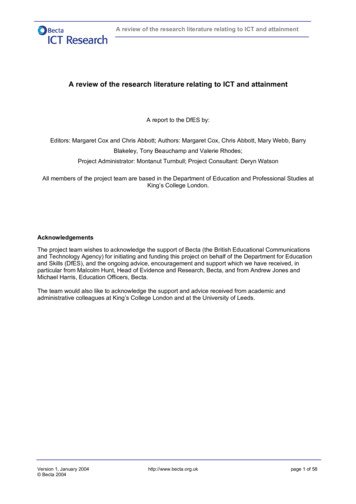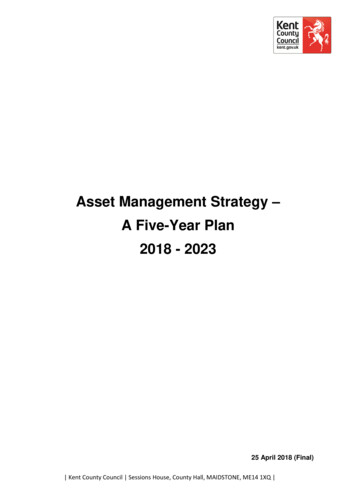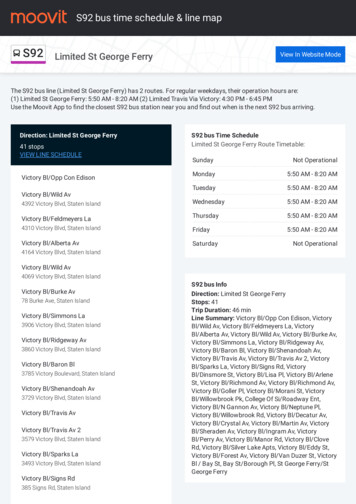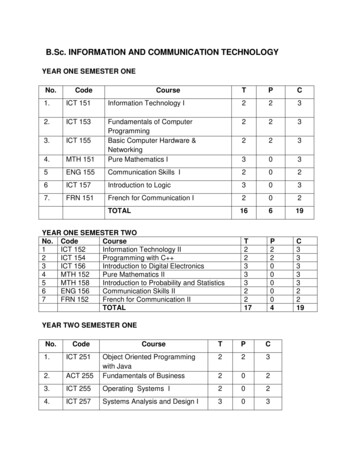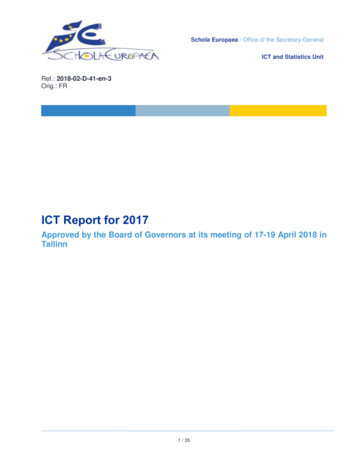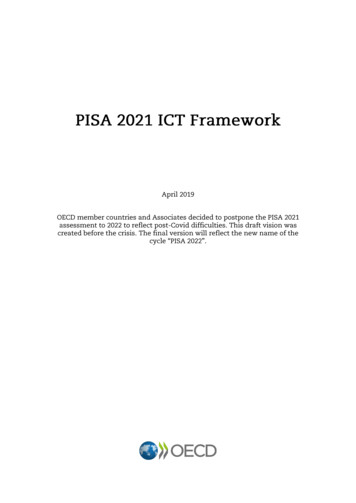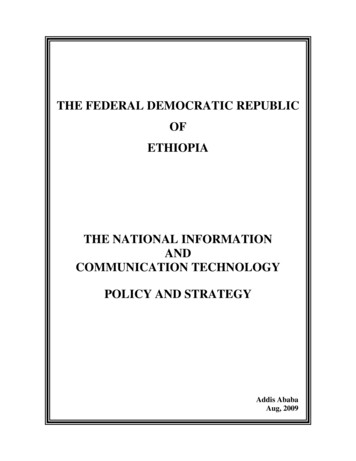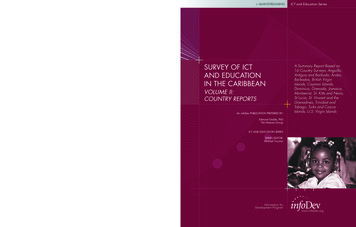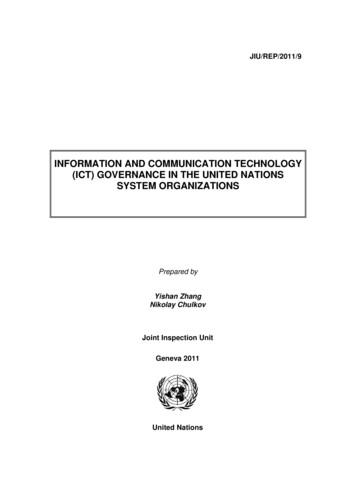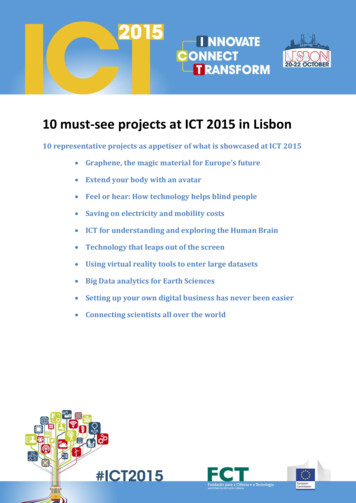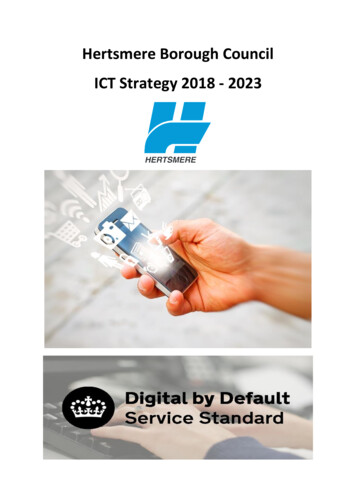
Transcription
Hertsmere Borough CouncilICT Strategy 2018 - 2023
Revision HistoryDateMarch 2017April 2017October 2017December 2017January 2018Version0.10.20.30.40.5February 20180.6March 20180.7DescriptionInitial DraftReviewed MBReviewed SBReviewed MBReviewed COBand SMTPolicy ReviewCommitteeExecutive approvalAuthorJohn Robinson
Table of Contents1.Executive Summary2.Definitions, Acronyms, Abbreviations and References3.Vision4.Context5.Overarching Technology Principles6.ICT Strategy Themes7.Priority Challenges and roadmap ActivitiesAppendix 1-The Corporate Technology StandardsAppendix 2-Business Systems MatrixAppendix 3-Projects Roadmap
1. Executive Summary1.1.PurposeThis document provides a comprehensive overview of the ICT strategy forHertsmere Borough Council for the period 2018 to 2023.1.2.ScopeThe objectives of this document are to: describe the ICT vision for HBC. demonstrate the close link between the ICT strategy, the transformationalstrategy, customer service strategy and the Enterprising Council vision. describe the key strategy areas required to realise the vision, and align ICTwith the Council’s business plan.This document is not intended to describe every strategic area in detail: these areaswill be supported by their own documentation. However, this document should beregarded as the overarching strategy document for HBC ICT.1.3The ChallengesHertsmere is a small district council serving a population of 104,000 residents.Hertsmere has a small dedicated and professional work force, service deliverystandards are high and resources have to be used efficiently.Over the next five years Hertsmere will witness significant changes. There will beincreasing financial pressures with the ongoing reduction of general GovernmentGrant, including the complete phasing out of the Revenue Support Grant by 2020.Further pressure will come from a changing population and changes in legislation.The shape and size of the council is likely to change and likely increase but the needto provide high quality services to our residents will remain. With these newchallenges will come new opportunities to use ICT to enable the Council to achieveefficiencies while maintaining and improving service delivery standards.ICT will be a key contributor to achieving the corporate vision of being anEnterprising Council and keeping pace with residents changing needs andexpectations.ICT is no longer just a support service; it has become a critical service. If it isunavailable, the organisation cannot operate. It has the ability to transform the wayservices are organised and delivered. It has a fundamental role to play in improvingefficiency, reducing cost across the organisation, exploiting income generatingopportunities and improving the customer experience.
Demand for public services and expectations of levels of service are everincreasing. Residents and businesses demand the same levels of access andpersonalisation that they see online from large private sector organisations such asAmazon and Tesco. They expect to be able to access their services from multiplelocations and devices and in ways and at times that suit them. This Strategy placesa strong emphasis on providing choice in the way people access our services. Thiswill ensure maximum choice for our residents which in turn will drive efficiencies inservice delivery.The risk of cyber-crime is increasing. Government statistics in 2017 showed seven inten organisations identifying a breach or attack. Organisations holding personal databeing most likely to be attacked, with the most common attacks being fraudulentemails, viruses and malware. Government are urging organisations to protectthemselves against cyber-crime.The General Data Protection Regulation (GDPR) comes into effect on 25 th May2018. All organisations which hold personal data will have to be compliant. Althoughinformation security is the responsibility of the Head of Legal and DemocraticServices ICT will have a major role in enabling compliance. Sanctions for noncompliance are sever The Head of Legal and Democratic Services is leading onGDPR.1.4Meeting the ChallengesMaking the website the channel of choice for most residents offers the opportunity toachieve significant savings for the council, while at the same time offering a betterservice.The financial case is powerful when the costs of the three main channels areconsidered. Estimates vary, but one provided by SOCITM shows:Face to Face 8.23 per visitPhone 3.21 per callWeb 0.39 per visitor
To be successful in encouraging residents to use web access to services andinformation we need to ensure their experience is a positive one otherwise they willbe unlikely to return.Considerable investment has been made in our back office business systems andthe foundations for electronic transaction processing have been put in place. Areview by our audit partners BDO has been commissioned to determine if allmodules procured have been implemented and are being used to their fullest extent,maximising the return, in terms of efficient use of a significant asset. This review willalso determine if current software remains fit for purpose. Any recommendations willfeed into this strategy.Digital thinking will need to embed into the organisation alongside a ‘can do’ attitude,developing a culture that puts resident’s needs and preferences first.Investing in our staff will remain a high priority. We will continue to improve the ICTskills of our workforce, equipping them with the skills they need to deliver a digitalbased service. We will continually review the replacement and upgrading of ICThardware and software to ensure that our workforce has the right solutions for theirwork and ensure they are properly trained to use it.Cloud technologies are now sufficiently mature to be considered a viable alternativeto traditional on premise solution. This strategy offers an evolutionary step towardscloud solutions rather than a revolutionary ‘big bang’ approach. Hertsmere haslimited resources and although this should not be a barrier to exploiting the benefitsof cloud, it must be approached in a measured way. We will begin this journey with aproject for disaster recovery and business continuity that will provide an ongoingfuture proofed solution.With the risk of suffering a cyber-attack only increasing, Hertsmere needs to ensureit protects itself should an attack prove to be successful. In addition to the physicalsecurity arrangements in place Hertsmere will also insure itself against a potentialcyber-attack. Our insurers Chubb have completed a cyber risk report on behalf ofHertsmere and our insurance underwriters Integro Insurance Brokers Limited. Therecommendations of the cyber risk report will be responded to by the IDS Managerand the Head of Legal and Democratic Services respectively. Integro will providequotation for a cyber insurance policy which the Head of Finance and BusinessServices will consider, subject to findings as required.Information and Digital Services will continue to ensure that Hertsmere maintains itsPublic Services Network (PSN) compliance and follow GDS best practice.A programme reviewing current working practices, rationalising officeaccommodation, eliminating unnecessary bureaucracy and administration all
supporting service delivery will drive efficiencies and could provide incomegenerating opportunitiesRecords management is at the heart of the Modernising Government agenda.Electronic records management underpins electronic government services. If as apublic authority we cannot undertake the effective management of our records andinformation - particularly keeping them organised and accessible for as long as theyare needed (but no longer), it will be hard to sustain electronic services in which thepublic can have trust. The General Data Protection Regulation (GDPR) whichreplaces the Data Protection Act (DPA) comes into force on 25 th May 2018, and willimpact on how long data is held and the rights of access by data subjects(residents). The Head of Legal who is responsible for data protection and informationsecurity will conduct a data audit and update the data retention policy in early 2018.
2Definitions, Acronyms, Abbreviations and ReferencesAcronym initionHertsmere Borough CouncilInformation Communication TechnologyWindows operating system / Intel chip set based devicesService Level AgreementPublic Services Network - helps public sectororganisations work together, reduce duplication andshare resources. Allows data to be shared from ournetwork to other PSN compliant governmentorganisations.Payment Card Industry – a data security standard forICT infrastructure that handles Payment Card dataThe EU General Data Protection Regulation (GDPR)replaces the Data Protection Directive 95/46/EC andwas designed to harmonize data privacy laws acrossEurope, to protect and empower all EU citizens dataprivacy and to reshape the way organizations across theregion approach data privacy.Government Digital ServiceSociety of IT ManagersDocumentCorporate PlanDigital by Default ServiceStandardDigital Efficiency ReportPSN Code of Connection(CoCo)GDPR Key ChangesPublisherHertsmere Borough CouncilGovernment Digital ServiceGovernment Digital ServiceCabinet OfficeThe EU General Data Protection Regulations
3 VisionVision StatementThe prime aim of this strategy is:“To support and underpin the aims and aspirations of Hertsmere as an EnterprisingCouncil through deployment of technologies and applications that will driveinnovation and efficiencies throughout the organisation”Please note that this vision is set within the council’s financial capability and within itscorporate priorities.The lives of our residents, staff and elected members have been transformed bytechnology. The internet has revolutionised the way that people communicate witheach other and transact their businesses. The mass consumer adoption of advancedtechnology is driving development of new ways of interacting with each other,business and government. Consumers now expect to be able to transact theirbusiness digitally with organisations 24 hours a day, 7 days a week.It is essential that the Council’s approach to ICT and digital services continues tobecome more structured, strategic and corporate. By doing this the value obtainedfrom Information and Technology across the organisation will increase.At present the Council hosts its own data centre, but in future this will not be costeffective. The future strategy will be to investigate opportunities to move ourinfrastructure to cloud or hosted services with the view to reducing costs, whilemaintaining reliability and security. Provisioning of disaster recovery will also beexplored in this way.The Council is currently supported by 40 application systems. These will be auditedin 2018 to determine whether they are fit for purpose in a digital age. The audit willalso look for process duplication with the view of reducing the number of systemwithin the organisation. The overall strategy for application systems will be to providefewer, more flexible best of breed application systems that allow the relevantinformation to be available where and when it is required. The increasing use ofcloud based applications will allow the Council to be agile in its adoption of newsolutions.The Council’s website along with other social media, such as Facebook and Twitter,have become and will continue to be a crucial information and service deliverychannel for residents, businesses and community groups. The usability of thewebsite is a crucial factor in encouraging take-up of new online services and indriving channel shift which is due to be updated during 2018. Digital transformationwill not only enhance the customer experience but will also be an enabler to theCouncil becoming more efficient.This ICT Strategy will support business transformation, in particular the developmentof digital media and will link closely with both the Transformation and CustomerServices Strategies.
4.ContextThe ICT strategy for Hertsmere Borough Council is based on the requirementsstemming from:Financial ClimateThe Enterprising CouncilThe national economic climate is extremely challenging withlow interest rates, higher than desirable inflation and slowgrowth anticipated for the foreseeable future. GeneralGovernment Grant will have been completely phased out by2020 by which time the Council will need to be financially selfsufficient.Hertsmere’s 2020 vision, exploring innovative ways to deliverservices.Additionally, the ICT Strategy is informed by the following trends and developmentsPublic Services Network (PSN)Cloud TechnologiesIncreased Supplier Choice(including Open )Digital by DefaultBig Data, Open DataInternet of ThingsThe PSN is the government’s high-performance network,which helps public sector organisations work together, reduceduplication and share resources. Public sector organisationscan access PSN-compliant services over the PSN.Local authorities must maintain an annual PSN compliance.Cloud computing has matured enough as an offering andshould be considered as the Council’s first choice to provideproducts rather than installing software and infrastructure onsite. Although cost and benefit will still be considered.The number and quality of suppliers offering robust and viabletechnology solutions has increased. This, alongside rapiddevelopment in the Open Source software market allowsorganisations to acquire high quality proven software solutionsat competitive licence costs.The Government Digital Service has continued on its push fordigital as its default access channel for central governmentservices. This is replicated in many private companies and localgovernment organisations as consumer use of digitaltechnology continues to grow and as a way of deliveringsavings.There has been an increased focus on data and in particularthe information and value we can gain from it – especiallylarge and complex data sets. From a technology viewpoint thesolutions available for extracting, analysing and publishing datahave matured significantly. There continues to be a strongpush from central government via its http://data.gov.ukinitiative for data to be published and freely shared whereverpossible. The Council needs to develop its ability to utilise dataeffectively to make better informed policy decision and to dothis in conjunction with other partners including health.This is a term used to describe how we might be able to learn,adapt and interact across many and varied technologies or“things”. This not only includes traditional software but alsosensors, monitors and connectivity in other disparateelectronic devices.
Delivering this strategy will create an ICT environment that is:Excellent value for money yetinnovativeScalable and flexible yet robustand reliableAccessible yet secureSupportable yet innovativeWhere investment is made, it will yield demonstrable benefitto the organisation and our residents.Able to change to rapidly fit the changing needs of theorganisation and our residents we serve ensuring servicesremain reliable and robust .Systems and technology can be accessed from wherever theorganisation requires whilst also enforcing a suitable level ofdata security.Commercial, cloud-deployed, off-the-shelf packages will beused with minimal customisation to ensure rapid, costeffective deployment, upgrade and simplified support.However there will also be a push for continually innovatingwith the technology choices and deployment we make.It should be noted that technology is only one component of change: it can only deliverexpected organisational benefits and savings in conjunction with: Business processes that are efficient and fit for purposeAdoption of new ways of working by the end user, be that employee or customerThe organisation must recognise the need for business transformation and be supportive ofthe ICT, Customer Services and Digital Transformational strategies.5. Overarching Technology PrinciplesThe Corporate Technology Standards link here shows details of the specific technicalstandards for the technology of the organisation. These directly support the followingoverarching technology principles;Cloud firstMobile friendlyCustomer PortalSingle version of the truthSecurity focussedProcurementOpen APIsWhere possible, practical and financially viable, cloudsolutions will be implemented. This will allow us to takeadvantage of greater scalability and resilience options.Where relevant, solutions will directly deliver or supportagile and mobile working.Where relevant, services that are customer facing will bedigitally enabled with an ICT service that can support the24/7 nature of digital self-service.Duplication and inefficiency will be removed bystreamlining, standardising and cleansing our datasets,making sure that data can be presented accurately,clearly and that it can flow between systems whererequired.Data and information security will be at the heart ofeverything we do along with our ever evolving andadvancing strategies and activities to protect us fromcyber threatsInformation and Digital Services (IDS) must be part of anyprocurement where technology is involved.Open APIs can be used by businesses seeking to
leverage the ever-growing community of freelancingdevelopers who have the ability to create innovativeapplications that add value to their core business. OpenAPIs are favored in the business sphere as theysimultaneously increase the production of new ideaswithout investing directly in development efforts of thesupplier.6.ICT Strategy ThemesA corporate ICT function must be driven by the needs of the organisation and from thecustomer’s perspective. Yet at the same time an ICT function must be a driver to help theorganisation exploit new technological advances. It should also produce benefits throughthe adoption of a joined-up approach for corporate information and technology assets. Thisstrategy focuses on ensuring that the technology within HBC is aligned with the strategicdirection of the Council and its Services.The need for a corporate wide ICT strategy continues to be important given that theorganisation continues to transform itself through the Enterprising Council programme. TheICT strategy will inform the prioritisation of tasks and projects within the ICT department.With the revenue support grant being phased out by 2020, local authorities must becomefinancially self-sufficient. ICT will be a key enabler in helping the Council secure a strongfinancial future . Therefore, it is expected that an especially tight financial focus will be anunderlying principle of all current and future projects. This will also affect the deliverycapacity within the ICT team and increases the need for prioritisation of projects andidentification of short term resourcing to deliver key priorities.ICT will continue to closely align itself to the Enterprising Council Programme and willunderpin Directorate projects. ICT expects to be delivering technology elements as part ofwider business process and staffing changes as part of the overall transformation agenda. Afailure of services to deliver the necessary process and people changes will result in a failureto realise ICT investment potential.In order to be able to support the organisation, the ICT strategy has been split into six mainthemes. Each of these themes has an evolving roadmap of activity supporting it. The themeswill not only address organisational pressures but also be driven and updated by widertechnology industry demands and trends.Our themes are:Technology infrastructureWorkspaceThe underlying foundation and building blocks for allof our ICT services.The day to day tools and technologies for end users
Customer engagementInformation assets and dataDigital innovationEnabling our services6.1The tools and technologies to work better with ourcustomers.Making the most out of the data we hold and collectPushing the boundaries of technology for theorganisation.Technology that works for and with our servicesTechnology Infrastructure6.1.1. BackgroundThis theme focusses on the underlying core technology infrastructure that supports the ICTservice providing the foundation and building blocks for any and all of the technology that weuse. This covers the technology that is used “behind the scenes” in our server room; thetelephony infrastructure; the ICT security infrastructure and the ICT networkinginfrastructure.6.1.2. VisionThe vision of this strategy is to deliver a resilient, reliable, efficient, up to date and highperforming infrastructure to support the technology we require. Our infrastructure mustand will be able to support the evolving way in which we use technology – being able to workfrom anywhere at any time and enable our customers to be able to access our servicesonline 24/7.6.1.3. PrinciplesThe main principles for this theme are: Innovate and rapidly adapt where possible and practical, taking advantage of newertechnologies such as cloud infrastructure services.Use of common technologies and platforms, consolidating where possible.Keeping infrastructure up to date and in line with industry compliance such as PSNand PCI.Proactive capacity and scalability planning striving for an “always on” ICT service.6.2. Workspace6.2.1. BackgroundThis theme focuses on the ICT tools and technologies that we all use on a day-to-day basisto do our jobs. The tools we use can have a direct impact on how efficient we can be andhow quickly we can do our jobs. This covers the physical ICT equipment everybody uses,the systems we access to do our jobs and how we electronically collaborate andcommunicate as an organisation.6.2.2. VisionThe vision of this theme is to provide resilient, reliable, efficient, up to date and highperforming systems and equipment to support new ways of working. Our systems and
equipment must and will be able to support the evolving way in which we use technology –being able to work from anywhere at any time and allow employees to collaborate andcommunicate in a modern and efficient manner. Staff training will be critical to success notonly ICT technical staff but also other staff who will exploit the technologies.6.2.3. Principles Innovate where possible taking advantage of newer technologies such as cloudsoftware services, mobile working and browser based systems.Use of common equipment, technologies and systems, consolidating wherepossible.Keeping equipment and systems up to date and in line with industry compliancesuch as PSN and PCI.Focus on equipment and system performance to ensure that best value is beingachieved from our technology investments.Keeping equipment and systems up to date and in line with industry compliancesuch as PSN and PCI.Focus on equipment and system performance to ensure that best value is beingachieved from our technology investments.6.3. Customer (internal and external) Engagement6.3.1. BackgroundLocal Government must change customers perceptions of what can be provided and howthis will be provided.Many people are already benefitting from the internet, digital TV and mobilecommunications. These offer opportunities to access services, save money, keep in touch,pursue personal interests and help with learning.This theme covers the technology that will provide new access channels and true selfservice to the residents of Hertsmere from any place and on any device.6.3.2. VisionThe vision of this theme is to provide a full, digital, self-service experience that deliversservices in a customer centric way on any platform and from anywhere. By default thepreferred method of contact with us will be through a Customer Portal. Customers will beable to pay online and see the progress of their request or incident when they want withouthaving to contact us directly. It is crucial that the ICT, Customer Services and DigitalTransformation strategies are aligned, and that ICT, Customer Services and DigitalTransformation work closely together to achieve this outcome.6.3.3. Principles Understanding our customers’ needs both internal and external and design servicesaround them and for them Aligning with the GDS Digital by Default Service Standard where possible. Make sure end to end digital services are available where and when customersneed to access them Data will be secure and pass seamlessly between corporate systems to ensure therequest is dealt with in the most efficient way.
Encouraging self-service whenever possibleResponding to customer feedback making our ICT services and changes accessibleand understandable to our internal customers6.4. Information Assets and Data6.4.1. BackgroundOur data is one of our most powerful and influential assets we hold as an organisation. TheHead of Legal and Democratic Services is responsible for data protection and informationsecurity. We must manage our data and information securely, efficiently, economically andeffectively whilst at the same time maintaining privacy and protecting customer data. Thiswill help enable delivery of the necessary efficiencies, improve our performance, improvecustomer service and allow us to be more open.This theme covers what we need to do in order to pass data and information seamlesslybetween corporate systems, share data externally and how we manage data centrally.6.4.2. VisionThe vision of this theme is to provide accurate and consolidated records for our mostimportant information. This will enable services to manage and control their own informationin an accurate and efficient way. Where required and relevant, data will be shared across theorganisation and externally to help design and underpin better public services.We will store information in a secure and robust location that will enable services to makebest use of management information. This will drive day to day service planning activities.6.4.3. Principles Know exactly what information we hold and the value we can gain from it,identifying core central data sets for the organisationCollect information once and re-use wherever possible striving for accurate andconsolidated recordsKeep information appropriately, lawfully and securely. To archive and dispose ofdata in line with retention policiesInformation is fit for purpose, quality validated and held in a fully secure andcompliant manner6.5. Digital Innovation6.5.1. BackgroundAs our customers increasingly use technology in their day to day lives, the demand for newand innovative ways to consume services is increasing. This has been driven by faster andcheaper broadband speeds, mobile networks and more powerful consumer devices. As theInternet of Things develops, new opportunities arise. ICT will work closely with the CustomerServices Manager and the Web Manager to ensure the best outcomes from theseopportunities for the Council and our residents.This theme covers the application of digital tools and infrastructure to enhance the residentcustomer experience in Hertsmere, and will be a critical enabler for the Customer Servicesstrategy.
6.5.2. VisionThe vision is to embrace the latest technology to deliver real change to the residents ofHertsmere.We will look for opportunities to drive innovation, through efficient use of new technologies,creating a culture of innovation. ICT must work closely with the Web Manager and inalignment with the Customer Services and Corporate Communications strategies.6.5.3. Principles Business and service led approach to driving technology innovationAccept and manage the risk on new digital initiatives rather than be adverse toinnovationBusiness benefit with minimal or positive council budgetary impact6.6. Enabling Our Services6.6.1. BackgroundICT underpins and supports all of our services in some way. It is essential that the ICTplatform and direction of travel aligns with that of the business it supports. This is especiallyimportant in the continual drive for efficiency via the use of technology across theorganisation. Where we are able to cost recover for our services, it is vital that the serviceoffering remains competitive in terms of cost and quality.This theme focusses on ensuring that the ICT service is closely aligned to the businessneeds of the organisation and maintains good performance.6.6.2. VisionThe vision of this theme is to provide a reliable and robust ICT service and platform that isaligned to our business needs. The service and platform will be adaptable to meet changingbusiness needs. Where costs are recovered for services then quality and cost will becontinually reviewed with a view to enhance our offering and increase uptake where possibleand viable.6.6.3. Principles Partnership opportunities are fully explored and developed where viableService offerings are continually assessed to ensure value for money is achievedwhilst delivering excellent ICT operational activitiesContinually striving for increased business efficiency and innovation throughgreater use of technology.7. Priority Challenges and Roadmap ActivitiesThe current key business challenges, future vision and technology proposals which drive theroadmap activity and underpin the ICT strategy are detailed below:
Note this section will be updated following the audit of business systems by our auditpartners B.D.O. and the review of cloud disaster recovery by SOCITM and then regularlythereafter.7.1. Current business challengesLimited availability of onlinetransactional services for ourresidentsPaper documentsDesk bound workingCustomer Relationship Management(CRM) systemStreet SceneEstate ManagementBusiness ContinuityParking ServicesGDPRData Retention Policy7.2. Future visionVery few Council services currently have ‘true’transactional presence.The Council has traditionally printed,photocopied and stored a large number ofdocuments, all requiring vast amounts of physicalstorage, and consuming office space.A reliance on paper, legacy telephony anddesktop IT provision
The objectives of this document are to: describe the ICT vision for HBC. demonstrate the close link between the ICT strategy, the transformational strategy, customer service strategy and the Enterprising Council vision. describe the key strategy areas required to realise the vision, and align ICT with the Council's business plan.
